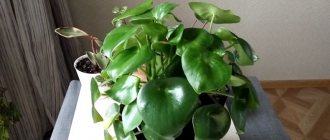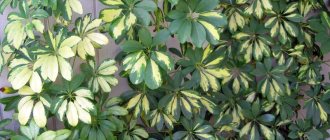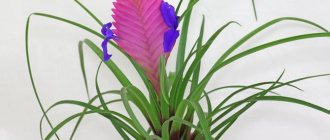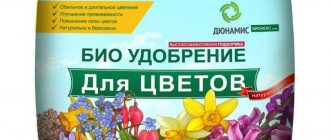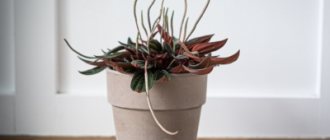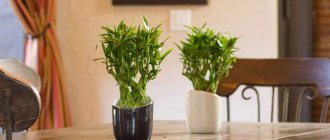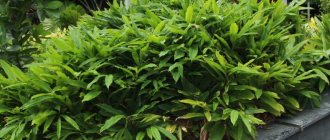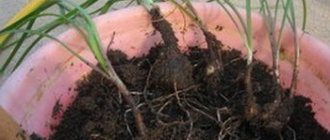Appearance and description of the plant
The main difference between all types of peperomia is the shape, color and thickness of the leaves. They are the usual green color, striped, with pronounced veins, white spots, fleshy or flat, curled.
It’s hard to say which ones are more beautiful. You can see small, hairy foliage on the peperomia, as well as the large, spotted, multi-colored variety.
Flowers are divided into three groups according to their shape:
- hanging - with hanging long shoots;
- shrubby – low stocky species, 15–20 cm high ;
- erect - taller varieties, up to 50 cm tall.
Each species has several subspecies and varieties, including hybrid ones. In total there are more than 1,000 names, scattered throughout their natural habitat - subtropics and tropics.
It is generally accepted that this plant is native to South and Central America. In nature, they can grow like epiphytes - on the branches of large trees, which provide them with shade, food and water.
Despite the fact that peperomia is a pepper crop, it is not used as a seasoning in everyday life. This is a full flowering plant that is more suitable for small spaces as it looks compact but luxurious.
The blooms are not as unique as the leaves. The inflorescences are more like plantain blossoms. Some people call them mouse tails.
What does Peperomia obtufolia look like?
Peperomia is a low herbaceous plant from the Pepper family. In nature, this flower lives in Central and South America, as well as in parts of Brazil and Ecuador.
The height of the plant, as a rule, does not exceed 40 cm. The structure of the shoots is thick, the leaves are round, 8 cm in diameter, dense, green, covered with an inconspicuous film. They are attached to the stem using petioles. The peduncles are spike-shaped, similar in shape to the peduncles of plantain.
Pereromia blooms almost imperceptibly, since its flowers are very small and inconspicuous.
The plant is mainly used as a hanging plant and grown on windows or balconies; it also looks good in hanging flowerpots.
There are several varieties of Peperomia obtufolia, their main differences being the color (solid dark green or variegated) and the shape of the leaves (oval, lanceolate).
Did you know? Because of the shape of the inflorescences, peperomia
is popularly called “rat tail”.
Interesting varieties with photos of peperomia
Peperomia obtufolia is best suited for home care, as it does not require special attention, unlike other tropical plants. She does not need a cool winter - the plant rests calmly on the windowsill. The requirements for soil nutrition are the most common, as well as for daylight hours and watering.
To choose a plant for yourself, you need to familiarize yourself with what a peperomia flower is and what types are available in stores. Some you can buy only in seed form and try to grow yourself.
Home care
Peperomia is native to the tropics of Central and South America; some species are common in Brazil, Asia, India and Ecuador. In nature, the plant is accustomed to humidity and good diffused light, as it inhabits the lower and middle tier. At home, peperomia belongs to the category of unpretentious indoor flowers that are easy to propagate and grow. In the store, you should choose the healthiest and most attractive plant - with perfect shiny leaves and thick elastic branches.
Basic growing rules:
- Conditions of detention. The preferred temperature range is up to +25° C, preferably without strong fluctuations. Peperomia prefers good light and develops well in partial shade. Direct rays of light have a detrimental effect on foliage. The plant needs a humid microclimate, it needs frequent watering and daily spraying.
- Priming. The best base for peperomia is well-drained fertile soil with neutral acidity. It is recommended to make the mixture from equal parts of turf and humus soil, peat and coarse sand. The flower pot must have a hole.
- Watering. The soil in the pot should not dry out; to do this, the plant should be provided with moderate and regular moisture. Watering should be done as needed: in summer - more often and more abundantly, in winter - less often and in a smaller volume. The main symptoms of lack of moisture are darkening and falling leaves.
- Fertilizer. Liquid flower food in half the dosage should be applied during the summer once every 2-3 weeks.
- Reproduction. The most popular method of propagating peperomia is from stem or leaf cuttings. They are rooted in wet sand or a mixture of sand and peat. Maintaining warmth and good moisture will allow you to achieve high-quality roots within a month. After this, the cuttings, as an independent plant, are transplanted into another pot.
- Transfer. Peperomia is relocated in the spring. This plant has a small root system, so the ideal container for it is wide and not deep. When planted, a high-quality cutting should have 2-3 leaves or internodes.
- Trimming. Sanitary pruning of diseased and dry branches is necessary for all varieties of peperomia. Experienced flower growers skillfully form beautiful bushes from regrown shoots of the plant. If the length of the branch exceeds 18-20 cm, it must also be trimmed. Heavy long branches often break off under their own weight.
- Peculiarities. The color contrast and decorative qualities of the flower are lost when moisture stagnates at the roots. Peperomia needs drainage - a sufficient layer at the bottom of the pot. On hot summer days, it is useful to place the plant on a tray filled with damp expanded clay or sphagnum.
Maintaining cleanliness is an important nuance of caring for Peperomia obtufolia. The plant will respond to frequent washing and abundant spraying with an impeccable appearance. Peperomia grows especially lush and fleshy in the humid and warm atmosphere of the kitchen. This beneficial flower enriches the indoor air with oxygen, purifying it of toxins and impurities.
Shrub species
50 species are cultivated in indoor gardening . Bush-like ones are one of the most beautiful and unusual. They reach 20 cm in height, but attract with their varied foliage - in shape and color.
wrinkled
Peperomia wrinkled received its name for its corrugated leaves, which can be of several colors - green, silver, purple. This is a compact species with short stems, similar to a cap. It blooms in late winter - early spring for two months. Breathable soil rich in organic matter and microelements is required. The plant is thermophilic.
Rosso
Caring for Peperomia Rosso at home comes down to providing it with nutrients - mainly nitrogen and phosphorus. The main interest for gardeners is the leaves. It is necessary to ensure that they are decorative so that the foliage is dark green and glossy.
Lillian
Peperomia caperata blooms beautifully with good care at home. The inflorescences are similar to lilies, which is why the flower was named. The color of the leaves is also of decorative interest - they are green with whitish veins.
Silver
Silver peperomia has an unusual leaf color. The veins seem to be recessed and of a darker color, and the swollen leaf plate is light, silvered. Due to the shortened petioles, large foliage is located very close to each other, which looks very beautiful.
Gray-haired
The “gray” effect is given to the plant by the edge of small hairs on the leaves. This is a fairly large plant that can grow up to 50 cm . Over time, the shoots begin to hang down.
Bambino
Refers to compact terrarium varieties. Peperomia bambino grows up to 15 cm - this is at best. Basically, its bright decorative leaves are used to create compositions in closed terrariums.
Peperomia Obtusifolia
A common type of blunt-leaved peperomia has a yellowish border along the edge. The leaves are shiny due to the waxy coating on their surface. The venation is pronounced and has an arched shape. The flowering is the same as that of all other varieties - inconspicuous, spike-shaped.
Peperomia obtusifolia
The shoots are initially erect, but then bend down under their own weight. The greatest decorative effect is achieved by hanging a flower pot on a wall or in a window opening, allowing the branches to hang down freely. Loves partial shade and daily spraying with warm boiled water.
For a beginner, keeping peperomia is difficult only because it does not tolerate neglect. Every morning it is necessary to check the soil moisture and perform traditional spraying. But bright greenery will be the best reward for daily attention.
Erect species
Many plants of this species have erect stems at a young age, but over time the fleshy leaves begin to outweigh and bend the shoots.
Tupolifolia
The leaves of Peperomia obtufolia have a round or even oval shape, the surface is glossy, without pubescence. There are two varieties:
- with dark green leaves;
- with spotted foliage.
Peperomia obtufolia is the easiest flower to care for; its requirements are similar to those of plants living in the middle zone.
Magnolifolia
Peperomia magnolia foliage resembles a fig tree in its foliage shape. The color is light green, the leaf blades are large, the stems are red. The peduncles are long and directed upward, so their appearance resembles some kind of fantastic plants.
Clusielifolia
Peperomia clusifolia is a multi-colored plant of the pepper family. A distinctive feature is very short petioles and large leaves - up to 15 cm in length and 8 cm in width. The variegated color is complemented by a bright pink edging along the edges of the foliage.
Ferreira
Peperomia ferreira is a succulent that stores moisture in its leaves. In nature it grows in dry places. It is also an epiphyte, so at home you can create entire compositions of tropical palm trees and their cohabitants.
Graveolens
Peperomia graveolens has leaves of unusual shape and color: slightly folded in half, red below, green above. They are fleshy and form a rosette. Flowering in the form of spikelets of a yellowish tint.
Chisel-shaped
Dolabriformis or chisel-shaped peperomia is a succulent. Fleshy, doubled leaves form a star-shaped rosette. Stems with leaves can grow up to 60 cm . This is one of the largest species. It blooms in small inflorescences of a white-green hue.
Variegated
Peperomia variegata is distinguished by its peculiar shade of leaf blades. In appearance it may be similar to clusielifolia, but without edging and a pink tint in color.
Variegated plants cannot be fed with nitrogen fertilizers. In this case, their leaf blades may lose their variegated color and turn green. Such varieties need high-quality lighting to maintain variegation.
Multicarpal
Polybotrya, raindrop or peperomia multitaste is a plant with round leaves. On some, the spouts are elongated and pointed, on others the leaf plates are completely round. The color is dark and glossy.
Peperomia: pruning
Overgrown bushes require formative pruning. This procedure is recommended to be carried out in the spring, but if necessary, you can use the summer or autumn months. Shoots that extend more than 30 cm in length are shortened. A section with 3-4 leaves is left, and the rest is cut off with sharp scissors or pruners.
After a short time, buds will appear at the cut, from which side shoots will grow. If you want to admire a beautiful bush for many years, then you need to take pruning seriously.
Ampelous plants
Hanging varieties can reach a length of 1.5 m . They need to be planted in a pot to avoid damage. Among them there are small-leaved and large-leaved species, which have different shades of stems and leaf blades.
Video: Peperomia - the most frequently asked questions about care
Creeping
Creeping peperomia most prefers soil and air moisture in care, since in nature it grows in wetlands. It is not picky to care for and is very decorative - the leaves can be either a regular green-light green color or variegated.
Golovataya
Peperomia capita glabella in nature is a creeping plant, but at home the stems grow long because they are not damaged. This plant does not have pronounced decorative qualities - the leaves are light green, oval in shape, and medium in size. If you grow a flower under the bright rays of the sun, the less bright the leaf plates become. The stems turn pink when exposed to ultraviolet light.
Round-leaved
This is a miniature compact plant. The size of its leaves is no larger than a penny coin, so it is used in terrarium compositions or in creating bonsai. no more than 15 cm in height .
This is a rather finicky species that can become infected with fungus if you water it carelessly and drops fall on the leaves. It is necessary to use watering through a tray. You should also not keep the bush exposed to direct sunlight.
Whorled
Peperomia whorled differs from similar species in the complete absence of petioles under the leaves, which are collected in whorls of 3 plates. The flower stalks are of interest - they are long and appear in early summer.
Watermelon
A decorative appearance that resembles a watermelon rind in color - a combination of silver and dark green stripes. This is not a hybrid variety, but a completely natural coloring of the plant. The shape of the leaf plate is ovoid, with a sharp nose.
This is more of a ground cover variety; in nature, this species lines the floor of the tropical jungle. Height no more than 12 cm . At home it can become an ampelous plant. It is also used to cover earthen voids under large palm trees.
Features of agricultural technology
It is considered an unpretentious flower. To preserve decorativeness, it is recommended to adhere to a number of rules. All types of peperomia are kept under the same conditions.
- Lighting and location. The best option is the western or eastern side. Keep out the sun. On the south side they are shaded with tulle or placed at a distance from the window. Species with dark leaves grow well in partial shade. Variegated varieties prefer bright but diffuse lighting. They are illuminated with fluorescent lamps. Caring for peperomia of variegated varieties is more difficult in this regard.
- Temperature. There is no rest period. Does not require special temperature conditions. The plant is kept at room temperature 18-22 °C all year round. Does not like cold and drafts. In winter, remove it from the window or place a sheet of foam under the pot. Do not take it outside or onto the balcony even in warm weather.
- Watering. In spring and summer, peperomia needs abundant watering. In autumn and winter, the frequency of watering is reduced. Water as the soil dries, maintaining stable humidity, but without waterlogging. Tap water is allowed to settle for two days. If possible, use soft water.
- Humidity. It tolerates dry apartment air calmly, but responds gratefully to periodic spraying.
- Feeding. Fertilize all year round. Use any complex preparations for deciduous plants. The concentration is reduced by 2 times. In the warm season, the frequency of fertilizing is every two weeks, in the cold season - monthly.
- The soil. The optimal soil for peperomia is loose, light, and well-permeable to water. For 2 parts of leaf soil take 1 part of peat, humus and sand. The addition of soaked hydrogel granules is encouraged.
- Transfer. The first three years are held every April. As you get older, the frequency of transplants is reduced. It is enough to replant adult peperomia once every 2-3 years. A drainage layer up to 5 cm thick is poured into the new pot.
Advice! Peperomia grows best in small, wide pots. Each time, take a pot 1.5 times larger than the old one.
Care requirements
Peperomia are not as difficult to care for as they are sometimes described. These are tropical crops, but they have long adapted to the conditions of the middle zone. It is recommended to grow plants taken from friends, as they are more adaptable than those sold in stores.
Depending on the type of flower, care requirements may vary slightly: some need more water, others less. The same goes for lighting and average temperatures.
If the plant was purchased in a store, it is quarantined. This is a general rule for all flowers, according to which the plant is checked for pests and diseases within 2 weeks . Then it can be placed with other crops on the windowsill.
Watering and humidity
In summer the amount of water is more, in winter – less. Glossy and regular species can be bathed in summer when the air temperature exceeds 27 degrees . Spraying and bathing are contraindicated for only two varieties - round-leaved and gray-haired peperomia. After this procedure, they turn black and die.
To protect the roots from excessive watering, it is recommended to fill the pot one third with drainage - stones, broken bricks, river pebbles. This draws liquid away from the roots, creates air pockets, and the root system can breathe without experiencing drought.
The water should be warm, especially in summer. Cold watering in hot weather can cause temperature shock and the roots will begin to rot.
Succulent varieties are rarely watered, as the plants store moisture reserves in case of drought. If you regularly overwater the roots, they will rot.
Lighting
East and west windows are the best option for this plant. It loves a lot of light. South-facing windows let in more light, so it is recommended to darken them with a curtain to avoid burning the leaf plates.
In winter, flowers lack natural light, so everyone who grows tropical crops tries to purchase phytolamps for evening illumination. In total, daylight hours should last at least 10 hours.
Temperature in summer and winter
Peperomia do not tolerate drafts, and all because in their homeland they grow in a humid forest climate where there is no wind. You should try to organize the same conditions at home. It is not recommended to take flowers outside, especially in windy weather - this can cause damage to the leaves.
Optimal temperature for peperomia:
- in summer from 20 to 22 degrees;
- in autumn from 18 to 20 .
The soil temperature must correspond to the air temperature, otherwise problems with the roots may begin. If the plant is on a cold windowsill, then you need to place insulation under the pot - mineral wool, basalt wool or polystyrene foam.
Pruning and shaping the bush
Every spring, peperomia bushes need to be renewed by pruning and cleaning. This procedure is useful in several ways:
- Removing dry leaves from inside the bush allows sunlight and air to penetrate to the young leaves, protecting them from fungus;
- weak and dead shoots are removed so that they do not consume nutrients;
- fallen leaves can become a source of fungal infection, so they must be removed regularly;
- With the help of pruning, a beautiful bush is formed.
Flowering of Peperomia obtufolia is sometimes delayed due to non-compliance with pruning rules.
Beneficial properties and harm
- Peperomia obtufolia is known primarily for its beneficial properties:
- aesthetic - this is a small ornamental plant with bright foliage of unique colors;
- disinfectants - cleans the air in the room from fungi and microorganisms due to the release of phytoncides;
- medicinal - improves the functionality of the stomach and intestines, urinary system and mammary glands.
The flower has no harmful properties and does not pose a danger to humans, since it does not contain any poisons or toxins.
However, Peperomia obtufolia is also accompanied by some superstitions and folk signs. Some of them are probably related to the healing properties of the plant.
- If there is peperomia in the house, love and prosperity will reign in the family.
- By growing this flower, you will protect yourself from quarrels and have enough money.
- It should not be accepted as a gift, as it will bring grief to the family. But if you buy the flower with a coin, misfortune can be avoided.
- If you grow peperomia at home, family members will rarely get sick.
- In the house where this flower grows, loyalty will remain, all family members will be close to each other.
- Being in the same room with a plant, a sick person recovers faster.
- By placing peperomia in the bedroom, you can get a good, healthy sleep.
Reproduction - methods and procedures
Peperomia is usually propagated by cuttings, as this is the most effective method. But there are others:
- seeds;
- sheet method;
- dividing the bush.
The seed method is quite risky, since not all sellers properly store seeds before sale. This reduces germination. The disadvantage of seed propagation is that the hybrid varieties next year will not be as beautiful as the mother plant. Therefore, seeds must either be purchased from the manufacturer, or another method of propagating peperomia must be used.
With the leaf method there is a greater chance of getting a new plant. You must follow the rules and procedures:
- Using a sharp knife, cut off the leaf with the internode or just the leaf.
- Treat it with root to increase strength.
- Place in water or damp soil (it can be done in different ways).
- Cover the container with film to ensure a constant microclimate.
- Wait 2 weeks - during this time roots should form.
- Transplant into a cup with soil.
Important! The soil for peperomia should be light, breathable, but nutritious. A mixture of sand, leaf humus, peat and garden soil is suitable. All components are taken in equal quantities. Plus you need to put drainage at the bottom
During growth, it is necessary to maintain a slightly acidic or neutral environment in the peperomia pot.
Propagating peperomia by dividing the bush is easier than growing from seeds or leaves. To do this, you need to remove the roots from the soil, cut them with a knife so that there is a root for each green part. Next, sprinkle the sections with activated carbon to prevent rotting, dry them a little in the air and plant them in separate containers.
If the bushes are small, they are temporarily covered with a transparent plastic bottle to organize the microclimate and protect the plants from drafts.
How to care at home?
In order for variegated peperomia to grow healthy and beautiful, you should know a number of requirements for its content.
Place and lighting
This flower requires moderate, diffused light without direct rays hitting the plant. It is best to keep the pot on the west or east side. However, if this is not possible, direct rays from the south window can be diffused using paper or translucent fabric. The duration of daylight hours should be 15-16 hours.
Temperature
In the spring-summer period, the temperature should be 20-22 degrees. In autumn not lower than 16 degrees
It is important to avoid drafts and sudden changes in air temperature
Watering
In spring and summer it needs abundant watering, by autumn - moderate. Water for irrigation should be slightly warmer than the general air temperature
It is important not to overwater the plant, otherwise the roots will inevitably rot. It is optimal to water when the top layer of soil is completely dry.
Important! Ambient humidity should be maintained at 60%, occasionally spraying the leaves.
Top dressing
It is important from spring to autumn to apply specialized fertilizers twice a month, which can most easily be purchased at a flower shop. Such drugs have a balanced composition
Pruning and replanting
Pruning is done as it grows. Here is a small guide to action if you decide to form a plant.
- Examine the peperonia and decide on the desired shape.
- Pinch the tops of the shoots at the level of the fifth or fourth leaf.
- If desired, you can root the cut parts.
Young peperomia are transplanted annually in the spring, over three years old - every two years. Below is a step-by-step guide to replanting:
- Choose the right pot. It should be only two to three centimeters larger than the previous one.
- Place a three-centimeter layer of drainage and the same amount of new soil at the bottom.
- Carefully remove the plant from the old pot and wash the root system.
- Place the flower in a new container and sprinkle with the rest of the soil. Do not compact the soil!
- Moisten the substrate a little and cover it with soil again.
The ideal soil would be a combination of peat, leaf soil and river sand in a ratio of 1:2:1.
Transfer
It is necessary to replant the bushes as the roots grow. This method allows the root system and top to develop in balance. This means that the size of the roots will correspond to the amount of green matter. If the balance is disturbed, the plant may weaken or even die.
The transplanting rule is that each next pot should be 2 cm larger in diameter than the previous one. This also prevents the soil from becoming too acidic, which will cause bush disease.
How to transplant peperomia:
- A week before transplanting, water the plant with a fertilizer solution to feed it.
- Prepare the soil and a new pot.
- Take out the bush, inspect the roots, remove rotten and dried ones, treat them with activated carbon or a solution of potassium permanganate.
- Make a hole in the soil and place the root there, using your fingers to gently compact the soil around it.
- Pour over warm water.
If the plants are mature and do not grow well, they also need to be transplanted into new nutrient soil, or at least replace the top layer of soil. This is done carefully so as not to damage the root system of the peperomia.
Table: diseases and pests typical for peperomia
| Name | Manifestation | Fighting methods |
| Root and root collar rot | The roots are affected first, followed by the leaves. The bush quickly withers, the root collar becomes watery, and the roots turn black. | At the earliest stage, all damaged parts are cut off, the entire plant with roots is dipped in a solution of the fungicide Switch 62.5 WG and planted in new soil. |
| Viral dwarfism | All parts of the peperomia are smaller than normal size and deformed. | No. |
| Spider mite | Multiple lightened and dried spots on the leaves. | Treatment with acaricides at intervals of two weeks until a positive effect occurs. Nisoran and Apollo are suitable. |
| Thrips | Visible to the naked eye - small (up to 2 mm in length) black insects on the leaves, which become sticky, turn yellow and dry out. | Double treatment with insecticides: actara, fitoverm, mospilan, karate. |
| Mealybug | A white and fluffy, mold-like coating appears on the leaves. | Twice, with an interval of two weeks, treatment with insecticides Fitoverm, Aktara. |
| Nematode | The first to suffer are the roots, which first thicken and then die. They are replaced by thin and sluggish ones. | Treatment with nematophagin and BI-58 helps. |
Important! If the pest is unknown, it is recommended to treat the ground part with afidol. It is sprayed on the shoots and leaves, and washed off after half an hour. After 5 days, the treatment is repeated. In total you will need up to five of them.
Fertilizers
Once a month during the active growing season, the plant must be fed with complex mixtures - liquid or dry.
For peperomia to bloom regularly, it needs potassium. To increase green mass - nitrogen. These two macroelements are introduced at different times: nitrogen in early spring, potassium closer to summer.
In order not to have to worry about calculating the amount of fertilizers yourself, you can buy ready-made mixtures for decorative deciduous plants. For spring fertilizing they will contain more nitrogen, for summer fertilizing - more potassium. The binding element is phosphorus. It is he who stimulates the growth of roots so that they provide nutrition to the above-ground part.
If you make an earthen mixture based on garden soil, it may lack some microelements. To do this, it is recommended to periodically apply fertilizing - a diluted solution containing copper, boron, iron, magnesium and other elements in microscopic dosages.
Caring for a flower indoors
Peperomia obtufolia (subspecies of peperomia variegata) is an ampelous plant, which is why it is so often used when creating complex green compositions. Peperomia has many decorative species, so decorators simply adore it.
Peperomia does not bloom, or rather its flowering is extremely inconspicuous (somewhat reminiscent of the flowering of plantain). Each inflorescence of the plant consists of several flowers that have a white tint. The active growing season falls during the warm season. The inflorescences have no aroma.
Peperomia obtufolia loves bright rooms, but cannot tolerate direct sunlight. Under the influence of aggressive sunlight, its leaves darken to a brown tint and wrinkle. This is a kind of sunburn.
You need to care for Peperomia obtufolia in the same way as all subspecies of the variegated variety.
Watering
The blunt-leaved variety requires regular and abundant watering. However, the substrate should not be allowed to become waterlogged or dry out. In summer, you can water once every 10 days, but in the cold season (especially in winter), adding water once every 14-21 days is enough.
For irrigation, you need to take only warm rain, snow or settled water, which will be slightly warmer than room temperature (a couple of degrees).
Periodically wipe the leaf plates with a damp, clean cloth and spray them
If there is a severe lack of moisture, you need to place the planting containers with these plants on plastic trays with wet gravel or pebbles.
Temperature and lighting
The most comfortable temperature indicators for peperomia are considered to be +20…+23 degrees. When the heat is above +28 degrees, it is already very difficult for her. In winter, it allows you to lower the standard indicators to +17...+18 degrees, and if you also reduce watering, you can count on the flower to withstand +10...+11 degrees. But if you plan to raise or lower the temperature in the plant room, then do it gradually.
Too low temperatures lead to depletion of the flower and its wilting. But too high a temperature can lead to loss of leaf blades and death of the plant.
When it comes to lighting for peperomia, you need to stick to moderate and diffused light. In principle, she loves light, but cannot stand direct sunlight. So it is best to keep flowerpots with flowers on a western or eastern window.
If it is not possible to place the plant to the west or east, then it is allowed to keep it on the south side, but provided that the light is diffused using translucent fabric or plain paper. Daylight hours should be approximately 14-16 hours.
Air humidity
You can also wipe the leaves with a damp cloth.
Peperomia loves high humidity, so it is best to place it next to its tropical counterparts. If you cannot achieve a humidity level of 60-70%, then place the flower pots on a tray with moistened expanded clay. It is also recommended to get a humidifier.
Which soil should you choose?
Most peperomia are not particularly picky about the soil. The ideal option would be a light and permeable substrate. You can make soil yourself by mixing equal parts of leaf and peat soil, as well as sand.
But it is best to choose a purchased soil option. It is considered universal and is suitable for most varieties of peperomia (including blunt-leaved).
The acidity of the substrate should be 5.5 to 6.5 pH.
Fertilizer and feeding
You need to fertilize peperomia at home once every two weeks. The procedure is carried out during the period of active development and growth of the flower (this is approximately the time from March to August). It is best to choose liquid mineral compounds for fertilizer that are added to water for irrigation. Reduce the dosage by 2 times relative to that indicated on the package.
You can tell that a plant needs fertilizer by looking at its young leaf blades. If they begin to get smaller, then this is a sure sign of lack of nutrition.
Description of the variety
Peperomia magnoliafolia belongs to the pepper family. Its homeland is the tropical forests of South America, most of it grows in Brazil.
The plant is considered a perennial. Its height reaches 25–30 meters. The stems are very large, fleshy, covered with many short-petioled leaves. They, in turn, have a round oval shape.
The leaf plate is smooth, a slight gloss is noticeable. The diameter of the leaves is about 5 cm. They are painted green, the shade varies from monochrome light to dark.
The magnolia-leaved peperomia has a “relative” – peperomia variegata. It doesn't bloom. In the magnolia-leaved plant, the flowering period still begins, however, the inflorescences do not differ in an unusual shape; rather, they resemble plantain spikelets.
Magnolifolia - a symbolic flower
Experts advise contradictory personalities, whose character is dominated by rebellion, to pay attention to the green bush. The plant creates a favorable atmosphere, smoothing out unevenness in human relationships and creating home comfort.
In addition, peperomia is very useful for the air in a living room - it has the ability to clean, moisturize, and destroy germs and bacteria.

